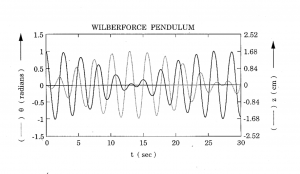The Wilberforce Pendulum is a type of pendulum that demonstrates a combination of torsional and longitudinal harmonic motion. It consists of a single mass (with two metal protrusions that each have a disk/nut that is threaded on) suspended from a spring that is suspended by a stand. The audience will see how simple harmonic motions can couple with each other and also how total energy transfer behaves between two different motions.
Materials:
- At least 6 foot of rod and a stand
- Wilberforce bob & spring
Instructions:
To demonstrate the oscillatory motion, simply attach the bob to the base of the spring suspended from a stand. When set in motion, the weight should go back and forth between completely rotational motion and completely vertical motion. If it never stops rotating, or going up and down, it must be adjusted by moving the discs. Start with each disc about 7 1/2 turns out from the cylinder, then make fine adjustments.
Explanation:
The Wilberforce Pendulum, named after physicist Lionel Robert Wilberforce is a system of coupled oscillatory motions. It demonstrates the energy transfer between torsional harmonic motion and longitudinal harmonic motion. This means at any given time when the system is in motion, it is highly likely that its motion will be a combination of torsional and longitudinal harmonic motion.
Firstly, we see that the period for a longitudinal oscillator such as a mass suspended from a uniform spring is:
where is the mass of the spring itself, and k is the spring constant.
For torsional motion, the period depends on the inertias of the object being oscillated. Thus, adjustments of the metal discs are crucial in finding the optimum distance to get the right inertia. For torsional motion,
where is the inertia of the spring and κ is the torsion constant of the spring.
Thus, the Wilberforce Pendulum is dependent more upon the inertia of the bob and the spring in comparison to a spring pendulum which only depends on the mass of the bob and the spring.

“Wilberforce pendulum oscillations and normal modes”. pg. 36 Richard E. Berg & Todd S. Marshall, Department of Physics and Astronomy, University of Maryland. College Park, Maryland 20742. 4 May 1990.
The pendulum’s total energy remains constant (ignoring friction and air resistance) thus its motion in itself will be perfectly harmonic, creating an envelope of sinusoidal motions(see Fig.1).
Like a object in space can be represented by (x,y) coordinates, a Wilberforce Pendulum can be represented by (z,θ). Thus, as seen in Fig. 1, both components of the objects motion vector (z,θ) are in opposite phases at any point, t. Where z is the displacement vector from the origin and θ is its respective angle.
Notes:
- This demonstration requires at least a 6 foot rod for suspension of the spring unless using a stiff spring.
- Alternatively, you could set the apparatus up with a short rod and have it hang off of the table.
- Expect to fiddle with the disks to find the best inertia for the pendulum to operate evenly.
Written by Phoenix Gallagher
